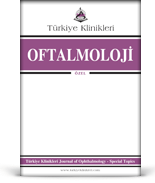Son yıllarda kornea ve oküler yüzey hastalıklarının tanı ve tedavisindeki gelişmeler, birçok hastanın kornea nakline ihtiyaç kalmaksızın tedavi edilmesini sağlamıştır. Buna rağmen hâlen yeterli görme keskinliğine ulaşabilmek için çok sayıda hasta kornea nakline gereksinim duymaktadır. Kornea nakli günümüzde en çok yapılan solid doku naklidir. Kornea ve ön kamaranın immün özerkliği nedeniyle, diğer organ ve doku transplantasyonlarından farklı olarak, çoğunlukla HLA-eşleşmesine ve sistemik immünsupresyona ihtiyaç duyulmamaktadır ve başarı oranları oldukça yüksektir.
Son yirmi yıldır kornea nakli cerrahisi ile ilgili pek çok gelişme kaydedilmiştir. Eskiden sadece tam kalınlıkta kornea nakli yapılırken, günümüzdeki gelişmelerle hastalıklı kornea tabakası değiştirilebilmektedir. Ülkemizde tüm yeni kornea nakli cerrahi teknikleri, dünyadaki gelişmelere paralel olarak başarı ile uygulanmaktadır.
Global körlük nedenleri içinde, kornea hastalıklarına bağlı görme kaybı ilk 5 sırada yer almaktadır. Tüm dünyada donör kornea temininde, bölgelere göre değişen, önemli derecede sıkıntı mevcuttur. Ülkemizde donör kornea teminindeki sıkıntılar son on yıldır hayli iyileşme göstermiştir. Hukuki problemlerin ilgili yasal düzenlemeler, yönetmelik ve yönergelerin yürürlüğe girmesi ile çözümlenmesi, 'Göz Bankaları'nın yeniden yapılanması ve hekimlerimizin kornea nakli konusunda ilgi ve becerilerinin artması ile son yıllarda Türkiye'de kornea nakli bekleme listeleri hızla eritilmiştir.
Bu kitapta amacımız kornea naklinde geçmişten günümüze gelişmeleri literatür bilgileri ve konusunda uzman hocalarımızın deneyimleri ile sizlere sunmak, bu gelişmelerin klinik uygulamalarımıza yansımasını sağlamaktır. Öncelikle kornea naklinin tarihsel gelişimi, keratoplasti teknikleri ve endikasyonları, ameliyat öncesi hasta hazırlığında dikkat edilmesi gerekenler, penetran keratoplasti cerrahisinin özellikleri, postoperatif hasta takibi, komplikasyonların yönetimi ve astigmatizma kontrolünü inceledik. Kornea naklinin immünolojisi, özellikli olgularda kornea nakli, günümüz koşullarında artan lameller keratoplasti endikasyonları ile ön ve arka lameller keratoplasti teknikleri, lazerin kornea naklindeki yeri, kornea naklinde katarakt cerrahisi, keratoprotez, kornea naklinde gelecekteki beklentilerimiz ve keratoplastiye alternatif tedavi yöntemleri konularını da detaylı olarak ele aldık.
Bu kitabın hazırlanmasında bilgi ve tecrübelerini aktaran tüm hocalarımıza, kitabın hazırlanmasında bizlere fırsat veren Türkiye Klinikleri Onursal Editörü Sayın Prof. Dr. Hikmet Akgül'e ve profesyonel yaklaşımları ile işleyişi kolaylaştıran yazı işleri ekibine teşekkür ederim.
Saygılarımla.
Prof. Dr. Ayşe BURCU
Editör
In recent years, advances in the diagnosis and treatment of corneal and ocular surface diseases have enabled many patients to be treated without the need for corneal transplantation. Despite this, many patients still require corneal transplantation to achieve adequate visual acuity. Corneal transplantation is the most commonly performed solid tissue transplantation today. Unlike other organ and tissue transplantations, HLA-matching and systemic immunosuppression are mostly not needed, due to the immune autonomy of the cornea and anterior chamber, and the success rates are quite high.
There have been many advances in corneal transplant surgery over the past two decades. While only full-thickness corneal transplantation was performed in the past, nowadays, due to current developments the diseased corneal layer could be replaced. In parallel with the developments in the world, all new corneal transplant surgical techniques are successfully applied in our country.
Among the causes of global blindness, vision loss due to corneal diseases is in the top 5 ranks. There is a significant problems in the supply of donor corneas at varying rates according to regions all over the world. In our country, the problems in the supply of donor corneas have improved considerably over the last ten years. With the resolution of legal problems with the enactment of the relevant legal regulations and directives, the restructuring of the 'Eye Banks' and the increase in the interest and skills of our physicians in cornea transplantation, the waiting lists for corneal transplantation in Turkey have been rapidly dissolved in recent years.
Our aim in this book is to present the developments from past to present in corneal transplantation with the knowledge of the literature and the experiences of our expert physicians, and to ensure that these developments are reflected in our clinical practices. First of all, we examined the historical development of corneal transplantation, keratoplasty techniques and indications, preoperative patient preparation, features of penetrating keratoplasty surgery, postoperative patient follow-up, management of complications and astigmatism control. We also discussed in detail the immunology of corneal transplantation, corneal transplantation in special cases, increasing lamellar keratoplasty indications in today's conditions, anterior and posterior lamellar keratoplasty techniques, the use of laser in corneal transplantation, cataract surgery in corneal transplantation, keratoprosthesis, our future expectations in corneal transplantation and alternative treatment methods to keratoplasty.
I would like to thank all our expert physicians who shared their knowledge and experience in the preparation of this book, the Honorary Editor of Türkiye Klinikleri Prof. Dr. Hikmet Akgül, who gave us the opportunity to prepare the book, and the editorial team who facilitated the process with their professional approach.
Kind regards.
Prof. Dr. Ayşe BURCU
Editor







.: Process List